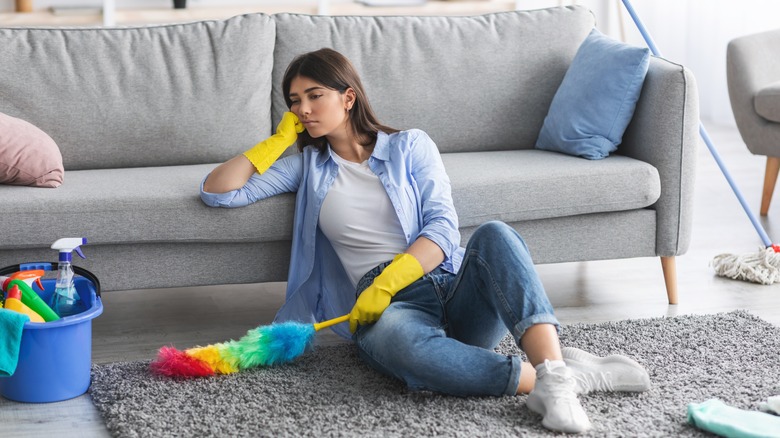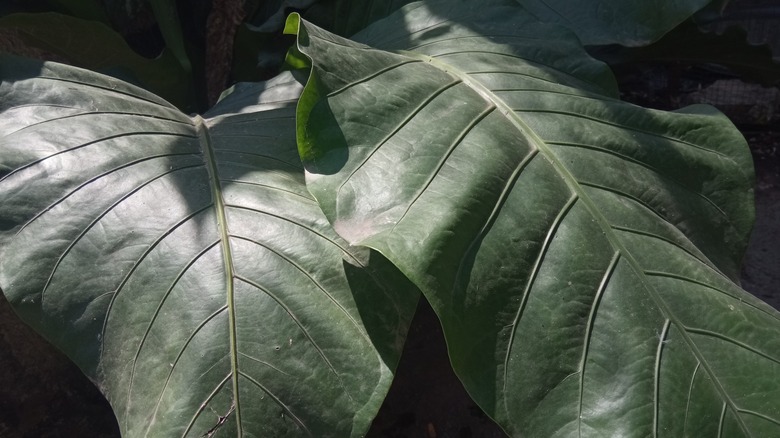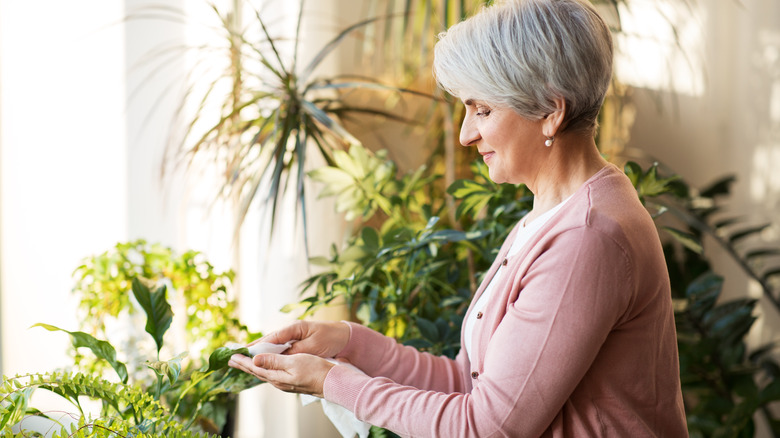Can Houseplants Help Your Never-Ending Battle Against Dust?
We may receive a commission on purchases made from links.
The hidden hazards of built-up dust in your home are not to be sneezed at. (Get it?) Dust irritates your airways and eyes. A surprising number of people worldwide — 5 to 30%, via a 2023 article published by StatPearls — are sensitive to dust mites. The teeny particles clog your air vents. Thankfully, that houseplant addiction you've developed has uses other than cheering you up after a particularly hard day at work. Think of leaves like nature's dustbusters — only they don't suck up the particles floating in the air as a vacuum would. Instead, the dust settles on the broad upper surfaces of leaves, removing it from the air.
Household dust comprises various — mostly yucky, honestly — teeny particles, like skin flakes (pet and human), synthetic and organic fibers (shed from, say, clothing), microplastics, and even bacteria and fungi. It's responsible for everything from allergic reactions to exposure to toxins like lead — not to mention a whole lot of energy expended on cleaning! In other words, banishing dust from your home is essential if you like clean air, good health, and more leisure time. So, how exactly do houseplants capture this floating, microscopic danger?
Houseplants as dust-collectors
Research suggests that if you put houseplants in a room, you'll reduce the amount of dust. The leaves act as mini filters, capturing airborne dust particulates on their surfaces. But why? For one, adding houseplants to your room increases the humidity levels. Damp plants are sticky, and that stickiness attracts dust. Plants also produce a tiny electrostatic charge, attracting anything light and floaty in the air to the leaves and stems, much like static pulls the hairs on your arm to a woolen sweater.
Cultivate houseplants with broad or textured leaves to take advantage of these attributes. When it comes to dust collection, the bigger or hairier the surface area, the better. Chinese evergreen (Aglaonema) boasts large, pretty pink and mint leaves — an Aglaonema 'Lady Valentine' in a 4-inch pot is $23.99 from Walmart. Peace lilies (Spathiphyllum) have deep green leaves and foliage-like green or white blooms. Buy an 8 to 10-inch tall plant from Lively Root for $43. Lowe's sells fuzzy-leaved African violets (Saintpaulia ionantha) in 13-ounce planters for $7.98. Crotons have enormous, shiny, multicolored leaves guaranteed to add drama to any room — buy small, 1-gallon plants from specialty grower Peter's Croton Nursey for between $32 and $49.
Give your plants a bath
Choosing the best dust-collecting plants doesn't mean creating a hideaway for your home's dust bunnies. You need to wipe those leaves down occasionally, especially if you want your plants to grow healthy and strong. A layer of dust blocks stomata (similar to the pores on our skin) and reduces the light received by the leaf's surface; the plant struggles to perform processes essential to growth, like photosynthesis, respiration, and transpiration. It also mutes the vibrant tropical leaf colors that you probably bought the plant for in the first place. Make sure, too, that it's actually dust on your houseplants and not a look-alike disease like gray mold, powdery mildew, or a spider mite infestation (they love dusty conditions).
Remedy this by cleaning your leaves often. Swipe a finger across the leaf, just as you would a dusty shelf. If you see where your finger traveled, or the tip of your finger is dark with dust, it's cleaning time! The quickest way to remove dust from a houseplant is to pop it in your kitchen sink, shower stall, or bathtub and gently spray it with lukewarm water. Alternatively, you can rub — again, gently — the leaves with a damp cloth or sponge and dust hard-to-reach places, like stems, flowers, or prickly cacti crevices, with a paintbrush. Avoid leaf shine sprays. They may inhibit essential leaf activities and even attract dust. If you really find that gleam all-important, rub some insect-deterring neem oil onto the leaves instead.


